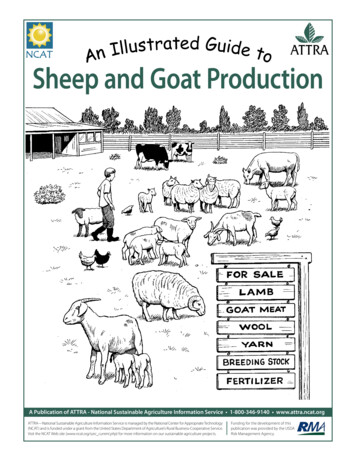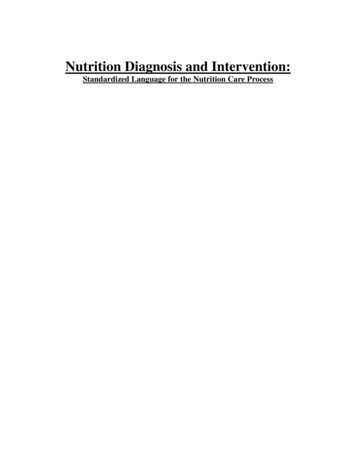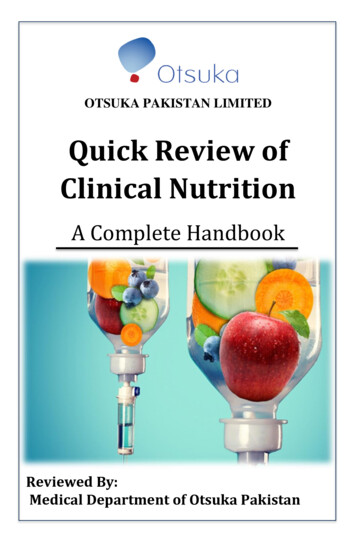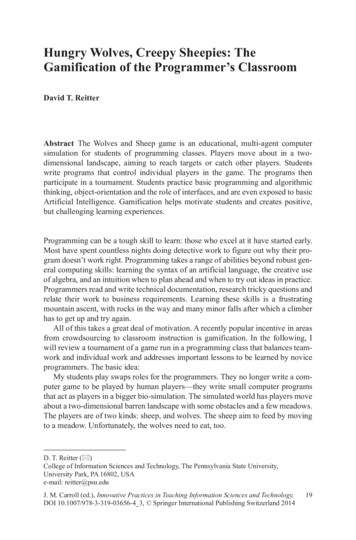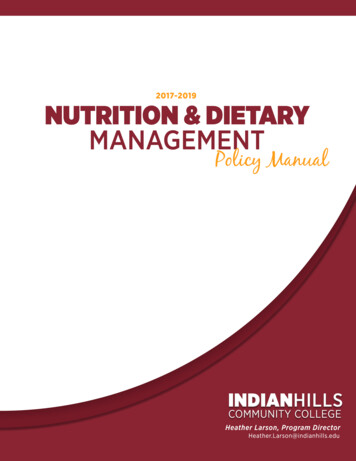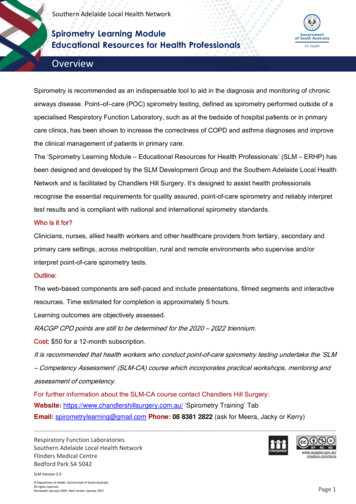
Transcription
Sheep NutritionFact SheetDeveloped by the Saskatchewan Sheep Development Board in conjunctionwith the Saskatchewan Ministry of Agriculture.Funding provided by Agriculture Council of Saskatchewan
Sheep NutritionFact SheetFeed vs. NutrientsDigestion in SheepA balanced feed ration is essential for normal health, growth andreproduction. Nutrients in the feed are utilized by the sheep tomeet their nutritional requirements. It is not the feed itself thatmeets these needs, but the components that make up the feed.Like cattle, sheep are ruminants. Aruminant animal has a compartmentalstomach which contains the rumen,reticulum, omasum and abomasum.The rumen allows the animal toconsume plant material and retain itlong enough to allow bacteria,protozoa and fungi to break down anddigest the material. The plant materialis consumed quickly, regurgitated andre-chewed and then swallowed. Thisprocess is called cud-chewing. Ahealthy mature sheep will chew theircud for several hours each day.DefinitionsProtein %Used for muscle and bone development, body maintenance andreproductive processes. Results are expressed as a percentageof the diet.Total Digestible Nutrients (TDN) %An estimate of the energy content in the diet which can be usedby the animal. TDN values are expressed as a percentage of thediet.Calcium %Important in bone strength and development, reproduction, milkproduction and body maintenance. Calcium levels are expressedas a percentage of the diet.Phosphorus %Required in association with calcium for proper bonedevelopment, energy processes and reproduction. Expressed asa percentage of the diet.WaterWater is the single most important nutrient required by livestock. Sheep require a daily amount of 1 gallonper 100 lbs of bodyweight. One square foot of surface water area must be provided for every 40 head ofsheep.Water can contain dissolved minerals, pollutants, micro-organisms, suspended solids as well as organic andinorganic compounds. Water sources should be tested to determine the quality, as poor water quality willhave negative affects on production.Maximum Safe Level (mg/1 or ppm)Total Dissolved Solids (TDS) 5000 - can cause diarrhea and digestive upsetSulfates (S04) 900 - reduces copper availability; associated with thiamine deficiencyNitrates 100 - additive with nitrates in feed; decreases Vit A and E, Iodine andPhosphorus availability
Body Condition ScoringBody weight and condition scoring can help producersmake important feed management decisionsthroughout the production cycle. Condition scoring is atechnique by which the producer can measure theamount of muscle and fat a sheep is carrying at acertain time.This information can be used tocategorize breeding animals relative to body fat andallows decisions to be made for maximum profitability.There are four important nutritional periods for the ewe: Flushing and breeding Last four weeks of gestation Lactation Dry periodEwes should be condition scored prior to flushing todetermine the effectiveness of flushing. Ewes with acondition score of 4-5 cannot be economically flushed,whereas ewes with a condition score 3-4 respond toflushing.** It is important to BCS some of the same ewes to geta realistic comparison each time.Spine prominent and smoothSpine prominent and sharpSpine rounded and smoothMuscles medium depthThin fat coverNo fat coverTransverseprocessroundedTransverseprocess sharpCondition 3 - AverageSpine not detectable; fat dimple over spineSpine detected only as a lineMuscles fullFat coververy thickMuscles very fullTransverseprocesscannot befeltCondition 4 - FatTransverseprocess smoothand roundedFingersneed hardpressure tofind endsCondition 2 - ThinFat cover thickMuscles fullModerate fatcoverFingers gounder withpressureFingerseasily passunderCondition 1 - EmaciatedNutritionBody condition scoring should be done at least threetimes per year. Six weeks prior to breeding, midpregnancy and in late pregnancy. To condition scorethe ewe should be felt over and around the backbone,in the loin region, behind the last rib and above thekidneys. This should be done with thumb and fingers.Ewes are scored on a scale of 0 - 5. A score of 0 is aewe that is completely emaciated, whereas a score of 5is a ewe that is extremely fat. Ideally, a score of 2.5should be achieved when on a maintenance ration andincreasing to a 3.5 prior to breeding. It is important tomaintain a body condition score of 3.5 for the first 30days following breeding to optimize conception rates.Score 1 Backbone feels very sharp, skeletal features areprominent with no fat cover Muscle is evident, but very shallowScore 2 Spinal processes have a smooth and rounded feeldue to depth of muscle tissue Absence of fat cover Animal appears thin but skeletal features aresmooth and do not protrudeScore 3 Loin muscle is full with moderate fat cover Spinal processes can be felt with pressure Fat can be felt in shoulder, tail head and fore ribareas Still recommended to flush prior to breedingScore 4 Spinal processes are covered with a moderatelayer of fat and muscle Overall appearance of the sheep is smooth,hipbone is not visible Firm fat deposits are evident in the tail head andbrisket This may be acceptable for the show ring but isconsidered too fat for breedingScore 5 The sheep are over fat They appear uncomfortable and reluctant to move Vertical process appears indented due to fat buildupTransverseprocess notdetectableCondition 5 - ObeseGraphics from the University of Kentucky College of Agriculture, Department of Animal Sciences
Requirements through the Production CycleNutritionNutrient requirements vary during the productioncycle as there are different demands put on the body.Ewes, rams, lambs and replacement ewe-lambs allhave varying nutritional needs. It is important to knowthe production phases and what is required for eachstage nutritionally.Suggested Dry Matter Intake(% of body weight)Ewe Maintenance1.75 - 2.20Flushing2.20 - 2.801st 15 Weeks of Gestation1.80 - 2.30Production phases: Ewes - Maintenance, Early and Late gestation,Lactation and Breeding Replacement Ewe-Lambs - Growth, Prebreeding, and Post breeding Lambs - Pre-weaning, Post weaning, andFinishing Rams - Maintenance, Pre-breeding, BreedingLast 4 Weeks of Gestation130-150% lamb crop2.20 - 2.60Last 4 Weeks of Gestation180-220% lamb crop2.40 - 3.00Lactation3.80 - 4.20Maintenance Production phase with lowest nutrientrequirements. Can use lowest quality feeds including pasture orpoor quality crop residue. Still require salt and minerals.Analysis of Feed Used - ForagesPre-Breeding/Flushing Ewes Increasing dietary energy prior to breeding. Usually done by increasing the level of grain inthe ration 30 days prior to ram turnout. Continue about 3 weeks after ram turnout. Minerals are important.Late Gestation The last 40-45 days before lambing. There is major fetal development during this timeand energy requirements increase substantially. A higher energy diet is required. Overfeeding at this time can cause dystocia.Lactation This phase requires a very high level of energy. Milk production peaks at 2-3 weeks after lambingand declines to a low by 8-10 weeks. Mineral supplementation is important.Suggested Nutrient Level in Diet (%)(Based on 100% dry matter)Maint.BreedingLatePreg.LactationFeedProtein TDN %Calcium PhosphorusAlfalfa16%551.5%.19%Grass Hay9.2%50.50%.16%OatGreen feed8.0%55.32%.20%Barley Straw4.2%45.40%.09%Lentil Straw6.4%46.65%.20%Flax Straw2.9%39.5.30%.20%Barley Silage12%59.46%.30%Vetch Hay18%581.25%.34%Dry Matter BasisAnalysis of Feed Used- Grains, Byproducts and SupplementsFeedProteinTDN entilScreenings21%77.11%.44%13 - 1672 - ePhosphorus0.200.180.240.29Dry Matter Basis38%
Feeding EwesNutrient Requirements 150 lb ewehandfuls of this ration in a feeding area availableonly to the lambs. Keep the feed fresh.A suggested creep and pre-grower ration is 18%protein and 90% Dry Matter nergyLate Gest.0.512.477.54.4Early Lac.1.003.7711.08.1Late Lac.0.632.616.85.3110 lbReplacement0.352.54.82.4Energy is the most limiting nutrient, and thereforethe most important nutrient in sheep rations.Energy is derived from carbohydrates, fats, oilsand protein in the ration and is generallymeasured as Total Digestible Nutrients (TDN) oras Digestible Energy (DE). It is the energy thatprovides fuel to enable the body to maintainnormal functions.Replacement ewe lambs must be fed appropriatelyand should be fed separately from the feedlotlambs. Feeding replacement ewes a finishingration will cause them to be too fat for breeding.Feeding RamsNutrient Requirements 275 lb ramProteinlbsTDNlbsCalcium reeding0.362.684.24.1Replacement(90 lbs)0.542.57.83.7Ram lambs can be fed similar to feeder lambs butshould not be allowed to over fatten. It is veryimportant to ensure that ram lambs receiveenough energy in their ration especially if beingutilized as breeding rams prior to reaching fullmaturity. If their energy requirements are not metit is possible to stunt their growth permanently.Feeding LambsCreep rations fed to lambs assist in rumendevelopment and allows for a quicker adaptation todry rations. Lambs can be started on a creepration as early as 7 to 10 days. Provide a fewInsufficient energy intake can lead to malnutritionand result in: Weight loss Reproductive failure Decreased milk production Lower resistance to parasites and disease Increased mortalityEnergy requirements vary depending on theenvironment as well as the stage of production.Factors that influence energy requirements are: Age of the ewe/ram Body condition Environment Disease and parasites Stage of production (gestation/lactation)ProteinProtein greatly affects production andreproduction. Inadequate levels of protein canresult in appetite reduction, thereby decreasingfeed intake which causes poor growth, poormuscular development and reduced reproductiveefficiency. Extremely low levels of protein cannotmaintain rumen microbes.Protein is degraded by the rumenal reticularmicro-organisms and synthesized into highquality microbial protein. For this reason, thequantity of the protein is more important than thequality fed in the ration.Protein requirements vary with the stage ofproduction. During late gestation and lactationNutritionA suggested feeding method would be to move theewe lambs from the feedlot to an area where theirfeeding can be controlled with a measured ration.Allow for a controlled finish and maturity.Things to Keep in Mind
Calcium & PhosphorusImportance of Feed TestingCalcium and phosphorus are interrelated in thedevelopment and maintenance of the skeleton.Forages and legumes are a good source of Ca,where as grains are a good source of P. Toomuch of either Ca or Phos can reduce theavailability of the other. A ratio of Ca:Phosshould be in the range of 1:1 to 5:1.It is very important to have your feed tested asnutrient levels vary depending on the quality ofthe feed.When planning your feed rations it is best toconsult with your nutritionist using your feed testresults. This will ensure that you are adequatelymeeting the nutrient requirements of yourlivestock during each stage of production.See the SSDB Sheep Minerals Fact Sheet for moreinformation.Sample Creep RationAlternativeNutrition%Alfalfa MealWheat (coarsely chopped)BarleySoybean Meal2:1 MineralSalt4038.51810.5#1lbs/100 lbs4038.51810.5%573.52010.5#2lbs/100 lbs573.52010.5Long stemmed, good quality hay should also be available to these lambs continuously to assist withproper rumen development.Sample Grower Ration (50-70 lb size)WheatBarley32% Protein Supplement2:1 MineralSalt%2556.517.01.00.5lbs/100 lbs81.517.01.00.5The grower ration can be fed up to 2.5 to 3.0 lbs per day. A good quality, long stemmed hay should beavailable at all times to allow for adequate fibre intake to help prevent digestive upset.Sample Finisher Ration (70 lbs - finish)Barley32 % Supplement2:1 MineralSalt%88.510.01.00.5lbs/100 lbs88.510.01.00.5The above ration can be fed at a level of up to 3 pounds per day or more. Long stemmed hay shouldbe available at all times to help maintain proper rumen function and reduce digestive upset.Note: The 2:1 mineral utilized in these rations should not contain more than 0.50% copper to prevent coppertoxicities. A vitamin premix should also be supplemented in the finishing ration. These sample rations weretaken from the Sheep Feeding Guidelines document put together by the Saskatchewan Feed Testing Laboratory.
Contacts:Agriculture Knowledge Centre1-(866) 457-2377aginfo@gov.sk.caPrairie Diagnostic Services (PDS)(306) 966-7316Pds.info@usask.cawww.pdsinc.ca52 Campus DriveSaskatoon, SK S7N 5B4Saskatchewan Ministry of AgricultureLivestock Branch - Regina(306) 787-4685Rm 202 3085 Albert AvenueRegina, SK S4S 0B1Livestock Branch - Saskatoon(306) 933-59923830 Thatcher AvenueSaskatoon, SK S7K 2H6www.agriculture.gov.sk.ca(306) 933-5200sheepdb@sasktel.netwww.sksheep.com2213C Hanselman CourtSaskatoon, SK S7L 6A8Western College of Veterinary Medicine (WCVM)(306) 966-7178www.usask.ca/wcvm/vth/lac/about.phpThis fact sheet has been prepared in conjunction with the Saskatchewan Ministry of Agriculture.Disclaimer: The information in this fact sheet are based on general averages and differences may occur among breeds and individual animals. The SSDBmakes no warranties expressed or implied about the information . It is the users responsibility to evaluate the accuracy and completeness of any content.NutritionSaskatchewan Sheep Development Board
Feed vs. Nutrients A balanced feed ration is essential for normal health, growth and reproduction. Nutrients in the feed are utilized by the sheep to . amount of muscle and fat a sheep is carrying at a certain time. This information can be used to categorize breeding animals relative to body fat

